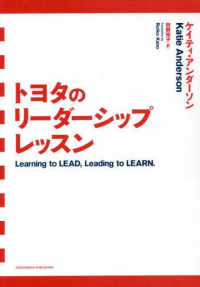Full Description
Educators need access to accurate and useful guidance on helping children and families who have been exposed to trauma. Learn the basics of what trauma is, what the effects can look like, and specific types of trauma that may be experienced as well as targeted suggestions for creating trauma-informed classrooms and practices that support children and families. This book brings together how educators can incorporate the community into trauma-aware practices, acknowledges and addresses the needs of educators, and offers solutions for caring for themselves as well as the populations they serve.
Contents
Preface
Chapter 1: Introduction
Why It Is Important to Understand Trauma
Prevalence of Trauma
Trauma-Informed Care
Early Childhood Educators Matter
A Path Forward
Chapter 2: Types of Trauma Experienced by Young Children
What Is Trauma?
Key Concepts Related to Trauma
Adverse Childhood Experiences
Causes of Trauma
Category 1: Household and Family
Category 2: Loss
Category 3: Family Separations
Category 4: Violence and Disasters
Post-Traumatic Stress Disorder
Role of Racism in Trauma and Child Well-Being
The Influence of Other Factors on Children's Experiences of Trauma
Responses to Trauma Are Individual
A Path Forward
Chapter 3: How Trauma Impacts Young Children's Brains and Their Ability to Learn
Brain Circuits and Connections
Experience and Brain Connections
Responding to Stress
The Impact of Trauma on Development and Learning
What Toxic Stress Looks Like in Early Childhood Programs
A Path Forward
Chapter 4: Guiding Principles for Teaching Children with Trauma
Principle 1: Recognize that All Children Will Benefit from a Trauma-Informed Approach
Principle 2: Use a Strengths-Based Approach to Teaching
Principle 3: Recognize, Appreciate, and Address Differing Influences on Children's Experiences with Trauma
Principle 4: Embrace Resilience as a Goal for Every Child
Principle 5: Help Children Learn to Regulate Their Emotions
Principle 6: Use Positive Guidance When Dealing with Children's Challenging Behaviors
Principle 7: Be a Role Model to Children on How to Act and Approach Learning
Principle 8: Help Children Turn Negative Thinking Around
Principle 9: Enrich the Children's Lives with Art, Music, and Dance
Principle 10: Look Beyond Children's Traumas and Celebrate the Joys in Life
Principle 11: Remember that You Don't Have to Have All the Answers
A Path Forward
Chapter 5: Establishing a Safe and Inviting Environment for Learning
Design a Physical Environment that Supports Children's Emotional, Social, Physical, and Learning Needs
Provide Materials that Support Learning and Healing
Bring Structure to the Environment Through the Daily Schedule
Tips for the Physical Environment
A Path Forward
Chapter 6: Connecting with Children
How to Foster Relationships When Children Have Experienced Trauma
Help Children Form Strong Friendships with Their Peers
Mindfulness As a Tool For Building Relationships and Other Needed Skills
Tips for Interacting with Children
A Path Forward
Chapter 7: The Healing Power of Play
Benefits of Play When There Is Trauma
A Right to Play?
The Impact of Trauma on Play
Using Play to Address Trauma's Negative Effects
Using Playful Learning with Children Who Are Distressed
When Violence Is a Part of Play
Tips for Using Children's Play as a Healing Agent
A Path Forward
Chapter 8: Partnering with Families
What Is a Family?
What Is Engagement?
Special Considerations in Working with Families of Children Who Have Experienced Trauma
Connecting with Families to Benefit Children
A Path Forward
Chapter 9: Trauma-Informed Care in Schools and Communities
TIC and the School Community
The Four Rs Framework and Six Principles of TIC
What TIC Looks Like in Action
Working with Your Administrator
Advocacy
A Path Forward
Chapter 10: Caring for Yourself
Your Own Compounding Stress
Defining Teaching-Related Stress
Using Self-Care to Overcome Secondary Trauma
A Path Forward
Appendix One: Resources for Educators
Appendix Two: Picture Books About Trauma
Appendix Three: Handouts for Families
References
Index
Acknowledgments
About the Authors








